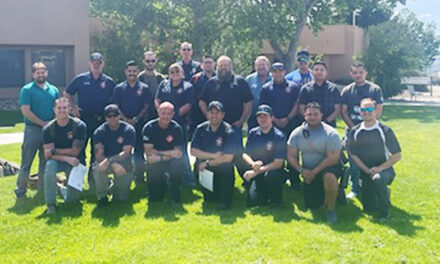(La Historia del Rio Abajo is a monthly column written by members of the Valencia County Historical Society. This month’s column would not have been possible without the kind assistance of Anne T. Williams, the Honorable Judge John W. Pope, Brian Graney of the New Mexico State Records Center and Archives in Santa Fe and Jamie Goldberg at the Valencia County Courthouse.
The Valencia County Historical Society is happy to announce that its newest publication will be available in November, just in time for Christmas. Written by Mar-garet Espinosa McDonald and Richard Melzer, it is a pictorial history of the county entitled, “Valencia County, New Mexico: History Through the Photographer’s Lens.” Anyone interested in information about the book and how to order it can call the Harvey House Museum at 861-0581.)
Forty-year-old Niichi “Nick” Yamate had just finished his evening shift as a railroad car inspector in the Santa Fe Railroad yards of Belen. Tired, he had returned home at about midnight on Thursday, Jan. 7, 1926.
Yamate sat down at his kitchen table to relax and read a newspaper by the light of a kerosene lamp. A can of smoking tobacco lay open on the table, suggesting that he also planned to smoke his pipe before retiring to bed.
Two other men were asleep elsewhere in the house. Yamate knew that both men were sound sleepers. Few, if any, sounds could awaken them.
A gunshot blast and the sound of breaking glass suddenly disrupted the quiet winter night. Hit in the head, Yamate slumped forward. He died almost instantly.
Yamate’s assassin turned from the shattered kitchen window and retreated quickly across the yard. He vaulted the backyard fence and headed for his nearby truck.
Throwing his rifle under the truck’s seat, Yamate’s killer slid off the sneakers he had worn to disguise his tracks. He put on his regular shoes and got into his truck. He had clearly planned his crime well.
After a short drive, the killer arrived at a second house. He quickly undressed and went to bed, prepared to testify that he had slept through the night. Even his alibi had been carefully planned.
Yamate’s body was discovered the following morning when his two houseguests awoke. They immediately reported the heinous crime to the local police. Neither man had heard Yamate arrive home, no less the single gunshot that had ended his life. They were indeed sound sleepers.
Newspapers in Belen and Albuquerque soon reported news of Yamate’s murder. Front-page articles told how the police were initially baffled by the crime. They had little evidence, no witnesses and no immediate suspects.
An autopsy only added to the mystery. Four physicians, including Dr. Samuel Wilkinson of Belen and Dr. William Randolph Lovelace of Albuquerque, discovered that the fatal bullet had entered Yamate’s head from just above his right ear, exiting the head just above his left ear. How could this be when Yamate’s head was supposedly turned so that his left ear was facing the window when the killer took his deadly aim?
Local police officers were soon joined by both private detectives and county lawmen. The Santa Fe dispatched railroad agents in case Yamate’s murder was somehow tied to his job as a railroad car inspector. Yamate’s relatives in California hired a Burns detective agency investigator, perhaps fearing that a Japanese-American’s case might not receive the same attention as a native New Mexican’s. The family also offered a $200 reward for information leading to the murderer’s apprehension and arrest.
Valencia County Sheriff Antonio J. Archuleta and his deputy Joe Tondre completed the investigative team gathered to find Yamate’s killer and bring him to justice.
Investigators first searched for a motive for Yamate’s murder. They soon learned that Yamate had been born in Japan but had moved to California and then to New Mexico. For several years, he had owned and operated a grocery store at Fourth Street and Copper Avenue in Albuquerque. He had moved to Belen when he went to work for the Santa Fe Railway. He lived in a house on a five-acre plot not far from the roundhouse and railroad yards where he worked.
Once settled in Valencia County, Yamate had met and married a daughter from the Chavez family of Peralta. The couple had one child, a daughter, born in 1922.
Unfortunately, Yamate’s wife had grown ill and had died of natural causes in September 1925. Yamate’s wife was not dead more than a few months when he asked his late wife’s 18-year-old sister, Elisa, to marry him. Elisa accepted. They were to be married on Jan. 18, 1926.
Marrying a deceased spouse’s sibling was not unusual in New Mexico in the 1920s. Only Yamate’s age, compared to Elisa’s, and the short time between his first wife’s death and his planned new marriage raised eyebrows in the community.
So perhaps the killer was among those who disapproved of the marriage ceremony planned for Jan. 18. Could he be a disgruntled former suitor?
If so, it certainly would not be the first time that a disappointed suitor was accused of murder in Valencia County. Readers of this column may well recall the tragic case of 17-year-old Adelita Jaramillo who was shot and killed by a rejected suitor as she waited for a train in the Los Lunas train station on the evening of Nov. 8, 1891.
Mindful of this possible motive, investigators in 1926 learned that as many as three men had an interest in asking for Elisa’s hand in marriage. All three were questioned. All three were now happily married to other women.
It appeared that the police and private investigators were stymied. According to the press, investigators did not even know if the killer had escaped from the murder scene by horse, by car, by truck or even on foot.
But did the murder victim have any personal enemies?
By all accounts, Yamate was a well-liked neighbor, employee and co-worker. Neighbors said that he was always willing to share anything he had with those in need. Reporters described him as a “perfect citizen” without a known enemy in the world.
But then deputy Joe Tondre discovered a key piece of crime scene evidence. As the former county sheriff, Tondre was hardly a novice in police investigations. He had investigated and successfully solved many mysteries in his career.
Retracing the killer’s route from Yamate’s window to his get-away vehicle, Tondre discovered a tiny bit of evidence that only he and a few others could have recognized as significant. The Los Lunas lawman found onionskins where the killer had exchanged the footwear he had worn to disguise his footprints.
Why were onionskins significant in this case? Because, as Tondre recalled, Elisa’s brothers, Emilio and Juan, had delivered a truck load of onions from Peralta to Belen just days before the murder. Could onionskins have dropped from one of the brothers’ shoes as he removed the tennis shoes and replaced them with his regular footwear?
Based on this evidence, the police detained both Emilio and Juan for the murder of Niichi Yamate. By the next day, 26-year-old Emilio confessed to the murder, taking sole responsibility for the deed so that his older brother could be exonerated and cleared as a suspect. Convinced that they had the right man, police officers released Juan and formally charged Emilio with the crime.
Emilio Chavez made a complete, signed confession. He freely admitted that he had purchased a .44 caliber Winchester rifle in late December 1925. He also told the police that he was staying at an in-law’s house in Belen on the night of Jan. 7. He had pretended to go to bed, but instead of dressing for bed, Emilio had kept his clothes and shoes on under the covers until all was quiet and he could leave the house undetected. He had left his in-laws’ house at about 11:30 p.m.
Driving to Yamate’s, Chavez had put on his tennis shoes, climbed over the fence, approached the kitchen window and found his human target quietly sitting at a table. After shooting a single shot, Chavez fled back over the fence, hurriedly changed his shoes, climbed into his truck and made his escape. He returned to bed in his in-laws’ house so that no one would suspect his involvement in the crime. All those who had seen him go to bed earlier in the evening could unwittingly be used to collaborate his alibi.
But why would Emilio Chavez want to kill the husband of his deceased sister and the future husband of his younger sister, Elisa?
Emilio was described as a bright young man who had studied at a Methodist school in Albuquerque before graduating from Belen High School in 1923. Since then, he had preached in Belen, worked for the railroad, and, most recently, grown crops, including onions, to sell in the valley.
Single, he was said to be very close to his family, including his widowed mother, his two “simple-minded” sisters and especially his youngest sister, Elisa. He worked hard to support his family and protect them in any way he could.
Chavez was said to be a “quiet boy” and “friendly towards all.” At 5-feet-7-inches and 136 pounds, he was a slim youth who had never been in trouble with the law. What could possibly be his motive for such a cold-blooded murder?
As it turned out, Chavez had two main motives for his actions.
First, he could not understand why Elisa would want to marry Nick Yamate. Chavez concluded that nothing short of magic could have convinced Elisa to marry her older brother-in-law. Yamate had, in fact, boasted to Chavez that he knew of a magical way to make any woman fall in love with him.
Chavez was convinced that Yamate must have used this “improper spell” on Elisa. After all, Elisa had once told Chavez that she would never marry Yamate, not even if he were a king.
But within weeks of uttering these words, Elisa had changed her mind and had promised to marry Yamate. Only magic could have caused this sudden change of heart. Emilio claimed that he had killed Yamate to save Elisa.
As so often happens in criminal cases, Chavez’s second motive had to do with money. When Chavez had learned that Yamate planned to marry Elisa, Chavez had asked Yamate for a “donation” to Elisa “for her protection” in case a disaster occurred sometime in her life. Yamate had refused, begging poverty.
To prove his lack of financial resources, Yamate had gone so far as to let Chavez see his bank account at the First National Bank of Belen. Yamate’s $56 account was not large, but Chavez and others suspected that the railroad worker had additional savings stashed in a bank in San Francisco. He also had a “considerable” life insurance policy and had property interests, although, as a Japanese-American, he could not legally own land or property directly.
Upset that Chavez had pried into his business affairs, Yamate reportedly said that if it were not for Elisa he would “get even” with his past and future brother-in-law. Chavez considered Yamate an enemy who might yet fulfill his threat to seek revenge.
With two clear motives, revealing evidence and a signed written confession, Valencia County District Attorney Fred Nicholas felt confident of conviction. Chavez’s trial was heard before Judge Harry Owen only two weeks following Yamate’s murder and two days before Yamate and Elisa were to be married.
Well aware of the futility of pleading innocent to first-degree murder, Chavez pleaded guilty to the lesser charge of second-degree murder. He waived his right to a trial by jury and refused legal counsel. In essence, Chavez threw himself on the mercy of the court.
Judge Owen willingly showed mercy because Chavez had confessed, had pleaded guilty and had saved the time and expense of a trial and prosecution. The judge may or may not have been further influenced by a letter that arrived in his chambers two days before Chavez’s sentencing.
The letter was written by A.L. Campo on behalf of himself and several other former students of the Harwood Methodist School that Chavez had attended for three years in Albuquerque. Campo stated that Chavez had been a good schoolmate and friend, although he had at times “acted queerly.”
Campo believed that Chavez’s unusual behavior was inherited from his now-deceased father. Campo concluded that anyone with such a background “cannot bear a crisis and when it comes they are likely to do just exactly what this fellow did.”
The letter writer asked the court to show clemency to Chavez “for all the family depends on Emilio to run things for them since he is the best educated of them all.”
For his part, Chavez made a brief statement when asked if he had anything to say before sentencing. He asserted to the court that “what I did, I thought I did with good intentions” to save Elisa. “But if I am guilty, I am willing to [face my penalty3/8 and do the best I can. I believe that God will [intervene3/8 and someday I will be a free man again. And I hope that what I did will help me later in life to be a better man and lead a better life, because after you [have had such3/8 an experience you can do better. That’s all I have to say.”
Judge Owen responded by sentencing Emilio Chavez to a term of no less than 90 and no more than 99 years of hard labor in the New Mexico state prison.
The judge minced few words in sentencing Chavez on Jan. 20, 1926. According to Owen, Chavez had “maliciously and willfully destroyed a God-given human life without legal justification or any moral excuse and without mitigating circumstances.” Based on “an imaginary grievance, you used a deadly gun, the weapon of a coward, and, at an hour when all was dark to cloak your cowardly action, you sent the bullet on its deadly mission.”
Judge Owen added that “While this life you have taken existed in the body of an Asiatic, it was not any less sacred under our law than if it had existed in a person of American birth or ancestry.”
Judge Owen declared that Chavez would have the rest of his life to suffer for his crime. As a high school graduate, Chavez “commanded an intelligence more keen than ordinary with which to comprehend the extent of your disgrace and the sorrow you have laid on your family and your friends.”
Chavez was led from the courtroom and transported to the state penitentiary in Santa Fe. He began serving his sentence on Jan. 22, 1926.
Community residents were relieved that Yamate’s murder mystery had been solved and that the streets and homes of Belen were safe once more.
And all were impressed by Joe Tondre’s sharp detective work. The veteran lawman had found the key bit of evidence that others had ignored when it literally lay at their feet. For this and his other good work, Tondre was appointed as New Mexico’s new U.S. Marshal later that same year.
The public was also impressed by how swiftly justice was served once the murder suspect had admitted his guilt. Chavez had escaped execution on the gallows by pleading guilty to second-degree murder, but his stiff penalty seemed onerous enough to fit his terrible crime.
While most seemed satisfied with the outcome of this case in 1926, we have no way of measuring public reaction to news of Emilio Chavez’s fate in early 1932. After serving only six years of his 90- to 99-year sentence, Chavez realized his sentencing-day hope that “someday I will be a free man again.” He was released on parole and allowed to return to Peralta to work and care for his family. A year later, Governor Arthur Seligman granted him a full pardon and a return of full citizenship.
Prison records do not reveal why Governor Seligman decided to parole Chavez at such an early date. Documents attest that Chavez had been a model prisoner, having “passed the entire period of his imprisonment without any violation of the rules and regulations of the penitentiary.” We can only speculate that the governor might have hoped to cut prison expenses by paroling certain less troublesome prisoners during the depression year of 1932.
Judge John W. Pope also reminds us that long sentences were not unusual in the early 20th century. Based on a different system of sentencing and parole than we use today, parole boards enjoyed far more discretion in determining the actual punishment for crimes, including crimes as serious as murder.
There is at least one other explanation for Emilio Chavez’s early release from prison. As Yamate’s California relatives had feared from the moment they had learned of his death, perhaps state officials did not take the railroad worker’s murder as seriously as other killings because of his Japanese ancestry. Despite Judge Owen’s assertion regarding his “Asiatic” heritage, race may well have played a part in the early release and pardon of Yamate’s murderer.
But Nick Yamate’s relatives in California were at least grateful to Joe Tondre, the man who had ignored Yamate’s race in solving the mystery of his murder and in apprehending his killer within a week of his death. Yamate’s relatives also appreciated the compassion Tondre showed to Yamate’s orphaned daughter, often looking out for her welfare in the succeeding years.
Anne T. Williams, Joe Tondre’s daughter, recalls that the Yamates expressed their appreciation to this dedicated police officer by taking him and his wife, Ruth, to dinner in San Francisco years later.
Joe Tondre never forgot that act of kindness in the wake of his most memorable murder case. And he never forgot what he firmly believed and expressed so well in a letter to a friend in 1930.
Racism, Tondre wrote, “gets us no place. … After all, we are all equal. It is the individual that counts, and not the race he is from.”
We can learn few greater lessons in our study of history.
(Editor’s note: Richard Melzer is a professor of history at the University of New Mexico-Valencia Campus and a longtime member and officer of the Valencia County Historical Society.)
The Valencia County News-Bulletin is a locally owned and operated community newspaper, dedicated to serving Valencia County since 1910 through the highest journalistic and professional business standards. The VCNB is published weekly on Thursdays, including holidays both in print and online.

















